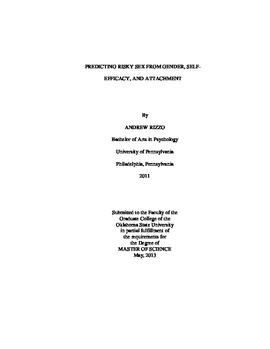| dc.contributor.advisor | Foubert, John D. | |
| dc.contributor.author | Rizzo, Andrew | |
| dc.date.accessioned | 2014-09-24T14:18:15Z | |
| dc.date.available | 2014-09-24T14:18:15Z | |
| dc.date.issued | 2013-05-01 | |
| dc.identifier.uri | https://hdl.handle.net/11244/11119 | |
| dc.description.abstract | This study examines college students' participation in risky sexual behaviors, a common aspect of contemporary college life referred to as "hookups". The study utilizes the Theory of Planned Behavior in constructing a predictive model that incorporated both individuals' stable characteristics and interpersonal skills. Specifically, this study examines gender, romantic attachment models of security and insecurity, and degree of self-efficacy regarding safe sex communication as predictors of college students' reported number of casual sexual partners, number of casual sexual encounters, and frequency of safe sex communication with casual sexual partners. Three research questions were asked to examine each of the indicators of sexual behavior. The research hypothesized that for each behavior the total model would be most predictive. The results supported only hypothesis 3; that is, the model significantly predicted variation in college students' reported frequency of safe sex communication with casual sexual partners. Furthermore, safe sex communication comfort was found to uniquely predict variance, controlling for romantic attachment and gender. Results from this study may help inform college-level sexual risk-reduction programming in terms of content of programs and ways to successfully engage students in proactive skill development that will lead to less involvement in risky sexual practices. | |
| dc.format | application/pdf | |
| dc.language | en_US | |
| dc.publisher | Oklahoma State University | |
| dc.rights | Copyright is held by the author who has granted the Oklahoma State University Library the non-exclusive right to share this material in its institutional repository. Contact Digital Library Services at lib-dls@okstate.edu or 405-744-9161 for the permission policy on the use, reproduction or distribution of this material. | |
| dc.title | Predicting Risky Sex From Gender, Self-Efficacy, and Attachment | |
| dc.type | text | |
| dc.contributor.committeeMember | Mwavita, Mwarumba | |
| dc.contributor.committeeMember | Brosi, Matthew | |
| osu.filename | Rizzo_okstate_0664M_12695.pdf | |
| osu.accesstype | Open Access | |
| dc.description.department | Education | |
| dc.type.genre | Thesis | |
